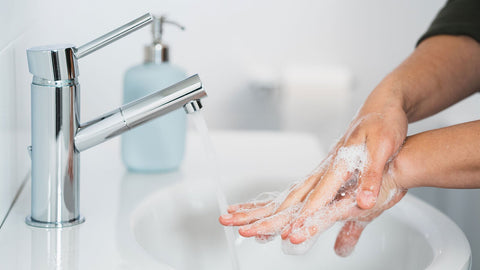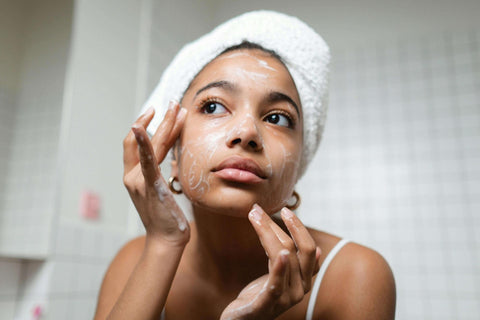
Heutzutage, hat der Aufstieg von selbstgemachtem, natürlichem Gesichtswaschmittel es ins Rampenlicht geschafft, da die Menschen dazu neigen, sich mehr um die nachhaltigen Auswirkungen und natürlichen Schönheitsroutinen zu kümmern. Dennoch sind Dinge, die viral gehen, nicht immer für jeden Einzelnen geeignet, besonders wenn sie sich im Allgemeinen auf Schönheit und im Besonderen auf Hautpflege beziehen.
Scrollen Sie in diesem Japan With Love Artikel nach unten, um tiefere Einblicke in natürliche Gesichtsreiniger zu erhalten, um den richtigen Ansatz für diesen Trend zu finden und Ihre Haut gut zu pflegen.
1. 3 überraschende Vorteile der Verwendung eines natürlichen DIY-Gesichtsreinigers
Zunächst einmal müssen wir verstehen, was eine natürliche Japanische Gesichtswäsche uns bringen kann, anstatt uns von den Hypes der Medien leiten zu lassen. Dieser Abschnitt konzentriert sich auf drei Hauptvorteile, die verdeutlichen können, warum Menschen dieser Hautpflege-Nische enorme Vorlieben einräumen.
1.1. Auf Ihren Hauttyp zugeschnitten
Einige Leute könnten argumentieren, dass jede andere Art von Gesichtswäsche Produkte nach Hauttyp kategorisiert. Jede Kategorie bietet jedoch immer noch die Bandbreite vieler Menschen, anstatt die Inhaltsstoffe und Formeln an Ihre individuellen Bedürfnisse anzupassen. Hier glänzt das selbstgemachte natürliche Gesichtswaschmittel.
DIY-Gesichtsreiniger machen ihrem Namen alle Ehre und folgen Rezepten, die auf Ihren Hauttyp und Ihre Vorlieben zugeschnitten sind. So können Sie sicher sein, dass es keine Chemikalien oder Inhaltsstoffe gibt, die Reizungen oder Allergien auf Ihrer Haut verursachen könnten.
Schauen Sie sich Die 5 besten japanischen Schaumgesichtswäschen für gesunde und glückliche Haut hier an, um Ihre Auswahl an Hautpflegeprodukten zu erweitern.
1.2. Sanfter und sicherer für Ihre Haut
Die Verwendung natürlicher Inhaltsstoffe macht Ihre Gesichtswäsche sanfter zu Ihrer Haut.
Der DIY-Teil befriedigt Ihr Bedürfnis nach Individualisierung, während die natürlichen Inhaltsstoffe Ihnen eine sanftere und sicherere Gesichtswäsche bieten. Selbstgemachte Gesichtsreiniger schließen alle aggressiven Chemikalien wie Parabene, Sulfate, Triclosan, Talk und Duftstoffe aus, die extreme Auswirkungen auf Ihre Haut haben könnten, insbesondere auf empfindliche Haut.
Darüber hinaus können sie Ihre Haut davor bewahren, durch die längere Verwendung starker Chemikalien in industriellen Gesichtswäschen geschwächt und geschädigt zu werden. Diese Art von Gesichtswäsche verwendet hauptsächlich Inhaltsstoffe aus natürlichen Quellen, wie z. B. Kräuter, um Ihre Haut zu beruhigen und sanft allen Schmutz zu entfernen, ohne das essentielle Sebum zu entfernen.
1.3. Umweltfreundlich
Die Verwendung von organischen und natürlichen Gesichtswäschen kann dazu beitragen, die Menge an Plastikverpackungen und den Verbrauch giftiger Materialien wie Paraben und Sulfat deutlich zu reduzieren. So kann es positive Auswirkungen auf unsere Umwelt haben.
2. Wie man einen natürlichen DIY-Gesichtsreiniger aufträgt
Obwohl sich der Anwendungsprozess nicht unterscheidet, gibt es einige Aspekte und zugehörige Tipps, die Sie kennen sollten, um das Beste aus diesem natürlichen Ansatz für Ihre Hautpflege herauszuholen. Hier ist eine Schritt-für-Schritt-Anleitung, wie Sie eine selbstgemachte Gesichtswäsche auftragen sollten.
2.1. Vor der Anwendung
Saubere Hände können Ihre Haut vor schädlichen Bakterien schützen.
Der erste Schritt ist, Ihre Hände zu reinigen, um mögliche Bakterien zu entfernen, die unerwartete Auswirkungen oder Allergien verursachen können. Ein zusätzlicher Tipp ist, Ihr Gesicht mit lauwarmem Wasser anzufeuchten, bevor Sie die Gesichtswäsche auftragen, da dies Schmutz und Unreinheiten aufweichen kann; dadurch wird die Schmutzentfernung viel einfacher.
2.2. Anwendung
Die Verwendung einer angemessenen Menge an Gesichtswäsche kann die natürlichen Öle Ihrer Haut erhalten.
Der nächste Schritt ist, eine erbsengroße Menge Gesichtswäsche auf Ihre Fingerspitzen aufzutragen. Eine solche Menge reicht aus, um positive Auswirkungen auf Ihr Gesicht zu haben, da die Verwendung von zu viel Ihrer Haut essentielle natürliche Öle entziehen kann.
Wenn Sie Ihr Gesicht mit dem Reiniger massieren, sollten Sie kreisende Bewegungen ausführen und sich auf Bereiche konzentrieren, die zu Fettigkeit neigen, wie z. B. die Stirn, die Nase und das Kinn. Seien Sie vorsichtig mit Ihrem speziellen Auge, da die Haut dort dünner ist und anfälliger für Reizungen.
Nach etwa 30 Sekunden sollten Sie Ihr Gesicht gründlich mit lauwarmem Wasser abspülen, um alle Spuren des Reinigers zu entfernen. Denken Sie daran, kein zu heißes Wasser zum Abspülen des Gesichts zu verwenden, da es Ihre Haut austrocknen kann.
Schauen Sie sich Dove Botanical Selection Schaumreiniger (Natural Radiance) 145ml - Japanischer Schaumreiniger an, um Ihre Hautpflegeauswahl zu erweitern.
2.3. Nach der Anwendung
Nicht reiben, sondern Ihr Gesicht sanft trocken tupfen.
Dieser Schritt ist nicht weniger wichtig als der Anwendungsschritt, was viele Menschen nicht erkennen. Reiben Sie Ihr Gesicht nicht grob ab, sondern tupfen Sie Ihr Gesicht sanft mit einem sauberen, weichen Handtuch trocken. Sie sollten auch auf die Materialien Ihres Handtuchs achten, ob sie Reizungen oder Allergien auf Ihrer Haut verursachen.
Wenn das Gesicht trocken ist, sollten Sie eine für Ihren Hauttyp geeignete Feuchtigkeitscreme auftragen, um die Haut mit Feuchtigkeit zu versorgen. Es wird dazu beitragen, eine gesunde Hautbarriere aufrechtzuerhalten, die den Alterungsprozess verlangsamen kann.
3. Wie man ein natürliches DIY-Gesichtswaschmittel herstellt
Wenn Sie eine aktivere Rolle bei Ihrer Hautpflege spielen möchten, wird die folgende Anleitung zur Herstellung von natürlichem Gesichtswaschmittel eine solide Grundlage bilden.
3.1. Schritt 1 - Zutaten auswählen
Die Erkenntnisse über Ihren Hauttyp, ob er trocken, fettig, empfindlich oder gemischt ist, sind entscheidend, um zu bestimmen, welche Inhaltsstoffe in Ihrem DIY-Gesichtsreiniger enthalten sein sollten. Zum Beispiel werden Ton (Bentonit und Kaolin) und Grüntee für fettige Haut empfohlen, während Jojobaöl, Avocado und Sheabutter die erste Wahl für trockene Haut sind. In diesem Sinne sollte eine gründliche Recherche und die Beratung von Experten Ihre Priorität in diesem Prozess sein.
3.2. Schritt 2 - Ein Rezept finden
Es gibt umfangreiche Informationen über ein natürliches DIY-Gesichtsreiniger-Rezept als Referenz und für Ihre Vorlieben. Wir werden hier drei beliebte Regime mit einfachen Prozessen und leicht zu findenden Zutaten vorstellen.

Sie sollten das am besten geeignete Rezept für selbstgemachte Gesichtsreiniger für Ihren Hauttyp finden.
-
Honig-Hafer-Genuss: je 1 Esslöffel roher Honig, fein gemahlene Haferflocken und lauwarmes Wasser für eine sanfte und Peeling-Reinigung.
-
Tonische Reinigung: 1 Esslöffel Ihres gewählten Tons mit 2 Esslöffeln Wasser oder Aloe-Vera-Gel für ein tiefenreinigendes Erlebnis, das für fettige Haut geeignet ist.
-
Feuchtigkeitsspendende Oase: 1 Esslöffel Naturjoghurt mit 1 Esslöffel Honig und einem Teelöffel Olivenöl für eine nährende Reinigung für trockene Haut.
3.3. Schritt 3 - Mischen und testen
Nachdem Sie das geeignete Rezept für die Herstellung Ihrer eigenen Gesichtswäsche ausgewählt haben, ist es an der Zeit, die Zutaten mit der im Rezept vorgeschlagenen Menge zu mischen. Nachdem die Mischung fertig ist, sollten Sie sie nicht sofort auf Ihr Gesicht auftragen, sondern sie 24 Stunden lang an einer kleinen Stelle Ihres inneren Arms testen, um auf allergische Reaktionen zu prüfen.
Wenn alles gut geht, können Sie mit der Verwendung Ihres DIY-Gesichtsreinigers beginnen. Wenn nicht, müssen Sie das Rezept ändern oder eine Expertenberatung einholen.
Haftungsausschluss: Die hier enthaltenen Informationen dienen nur zu Bildungszwecken und sollten nicht als medizinischer Rat verstanden werden. Die beste Option ist, einen Dermatologen zu konsultieren, bevor Sie mit einer neuen Hautpflege beginnen, insbesondere wenn Sie an einer Hauterkrankung leiden.
Hol dir das jetzt:🌟 Cow Brand Soap Natural Comfortable Sake Lees Face Wash Soap 80g - Gesichtsreinigungsseife
4. FAQs
4.1. Ist die Verwendung eines natürlichen DIY-Gesichtswaschmittels wirksam?
Botanische Inhaltsstoffe Ihrer selbstgemachten Gesichtswäsche können gut funktionieren, um Ihre Haut sanft zu reinigen.
Ja, das ist es. Der Gesichtsreiniger kann Ihren Zweck der Hautreinigung mit einem sanfteren Ansatz erfüllen, indem er natürliche Inhaltsstoffe anstelle von aggressiven Chemikalien verwendet. Die Wirksamkeit ist jedoch nur dann offensichtlich, wenn alles zu Ihrem Hauttyp passt, wie z. B. das von Ihnen gewählte Rezept, die Art und Weise, wie Sie es anwenden, und wie Sie den Reiniger lagern.
Neben der Herstellung von DIY-Gesichtswäschen können Sie auch getestete Japanische Gesichtswäsche Produkte verwenden, da diese auch natürliche Inhaltsstoffe für eine sanftere Reinigung verwenden, ohne alle wichtigen Öle von Ihrer Haut zu entfernen.
4.2. Wie sollte ich einen DIY-Gesichtsreiniger aufbewahren?
Sie können alle Zutaten gemäß dem Rezept mischen und die Mischung in einem luftdichten Behälter an einem trockenen, kühlen Ort aufbewahren. Der beste Tipp ist, kleinere Chargen für eine frischere Verwendung und eine bessere Lagerung herzustellen, da keine Konservierungsstoffe vorhanden sind. Eine andere Möglichkeit ist, Ihre frischen Materialien aufzubewahren und sie direkt vor Ihrer Gesichtswäsche zu mischen.
4.3. Was sind die besten natürlichen Gesichtsreiniger?
Einige empfohlene Gesichtswäschen, die direkt an die Spitze gelangen, sind Hatomugi-Reiniger und SK II-Reiniger. Es gibt viele tolle Empfehlungen auf dem Markt zu budgetfreundlichen Preisen. Der beste Tipp ist, auf die Inhaltsstoffe zu achten, die hauptsächlich aus Kräutern oder botanischen Quellen stammen und keine aggressiven Chemikalien wie Sulfat, Alkohol und Paraben enthalten sollten.
5. Fazit
Wir hoffen, dass die umfassende Schritt-für-Schritt-Anleitung zu selbstgemachtem, natürlichem Gesichtswaschmittel Ihnen hilfreiche Einblicke und praktische Empfehlungen zu Rezepten, Anwendungsanleitungen und zusätzlichen Tipps gegeben hat. Folgen Sie Japan With Love, um weitere aktuelle Informationen zu Schönheitstipps und erstaunlichen Hautpflegeprodukten zu erhalten.



















Teilen:
Wie man Kawaii Make-up macht: Eine Schritt-für-Schritt-Anleitung für ein perfektes
Wie man zu Hause einen Nagelknipser benutzt: Eine Schritt-für-Schritt-Anleitung